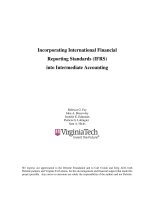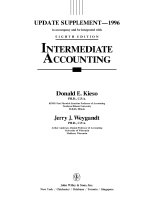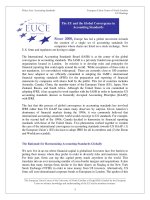Intermediate Accounting - Chap008 doc
Bạn đang xem bản rút gọn của tài liệu. Xem và tải ngay bản đầy đủ của tài liệu tại đây (3.85 MB, 88 trang )
Copyright © 2007 by The McGraw-Hill Companies, Inc. All rights reserved.
Inventories:
Measurement
8
8-2
Inventory
Those assets that a company:
2. Has in production (work in process)
for future sale.
2. Has in production (work in process)
for future sale.
1. Intends to sell in the normal
course of business.
1. Intends to sell in the normal
course of business.
3. Uses currently in the production
of goods to be sold (raw materials).
3. Uses currently in the production
of goods to be sold (raw materials).
8-3
Types of Inventories
Merchandise
Inventory
Merchandise
Inventory
Goods acquired for
resale
Goods acquired for
resale
Manufacturing
Inventory
Manufacturing
Inventory
•
Raw Materials
•
Work-in-Process
•
Finished Goods
•
Raw Materials
•
Work-in-Process
•
Finished Goods
Types of Inventory
Types of Inventory
8-4
Inventory Cost Flows
Raw
Materials
(1) $XX
$XX (4)
Work in
Process
Finished
Goods
Cost of Good
Sold
Direct
Labor
Manufacturing
Overhead
$XX
$XX (7)
$XX $XX (8)
$XX
(2) $XX
$XX (5)
(3) $XX
$XX (6)
(1) Raw materials purchased
(2) Direct labor incurred
(3) Manufacturing overhead incurred
(4) Raw materials used
(5) Direct labor applied
(6) Manufacturing overhead applied
(7) Work in process transferred to finished goods
(8) Finished goods sold
(1) Raw materials purchased
(2) Direct labor incurred
(3) Manufacturing overhead incurred
(4) Raw materials used
(5) Direct labor applied
(6) Manufacturing overhead applied
(7) Work in process transferred to finished goods
(8) Finished goods sold
8-5
Learning Objective
Explain the difference between a
perpetual inventory system and a
periodic inventory system.
8-6
Inventory Methods
Perpetual Inventory
System
Perpetual Inventory
System
The inventory
account is
continuously
updated as
purchases and
sales are made.
The inventory
account is
continuously
updated as
purchases and
sales are made.
Periodic Inventory
System
Periodic Inventory
System
The inventory
The inventory
account is adjusted
account is adjusted
at the end of a
at the end of a
reporting cycle.
reporting cycle.
The inventory
The inventory
account is adjusted
account is adjusted
at the end of a
at the end of a
reporting cycle.
reporting cycle.
Two accounting systems are used to record
transactions involving inventory:
8-7
Perpetual Inventory System
Matrix, Inc. purchases on account $600,000
of merchandise for resale to customers.
GENERAL JOURNAL
Date Description Debit Credit
Inventory
600,000
Accounts Payable
600,000
2006
Returns of inventory are credited to the inventory account.
Discounts on inventory purchases can be recorded using the
gross or net method.
Returns of inventory are credited to the inventory account.
Discounts on inventory purchases can be recorded using the
gross or net method.
8-8
Perpetual Inventory System
Matrix, Inc. sold, on account, inventory with a
retail price of $820,000 and a cost basis
of $540,000, to a customer.
GENERAL JOURNAL
Date Description Debit Credit
Accounts Receivable 820,000
Sales
Cost of Goods Sold 540,000
Inventory
820,000
540,000
2006
8-9
Periodic Cost of Goods Sold Equation
Beginning Inventory
+ Net Purchases
Cost of Goods
Available for Sale
-
Ending Inventory
= Cost of Goods Sold
8-10
Periodic Inventory System
Matrix, Inc. purchases on account $600,000
of merchandise for resale to customers.
GENERAL JOURNAL
Date Description Debit Credit
Purchases
600,000
Accounts Payable
600,000
2006
Returns of inventory are credited to the
Purchase Returns and
Purchase Returns and
Allowances
Allowances account.
Discounts on inventory purchases can be recorded using the
gross or net method.
Returns of inventory are credited to the
Purchase Returns and
Purchase Returns and
Allowances
Allowances account.
Discounts on inventory purchases can be recorded using the
gross or net method.
8-11
Periodic Inventory System
Matrix, Inc. sold on account, inventory with a
retail price of $820,000 and a cost basis
of $540,000, to a customer.
GENERAL JOURNAL
Date Description Debit Credit
Accounts Receivable 820,000
Sales
820,000
2006
No entry is made to record Cost of Good Sold. Assuming Beginning
Inventory of $120,000. A physical count of Ending Inventory shows
a balance of $180,000. Let’s calculate Cost of Goods Sold at
the end of the accounting period.
No entry is made to record Cost of Good Sold. Assuming Beginning
Inventory of $120,000. A physical count of Ending Inventory shows
a balance of $180,000. Let’s calculate Cost of Goods Sold at
the end of the accounting period.
8-12
Periodic Inventory System
Adjusting entry to determine Cost of Goods Sold
8-13
Comparison of Inventory Systems
8-14
Learning Objective
Explain which physical quantities of goods
should be included in inventory.
8-15
What is Included in Inventory?
General Rule
All goods owned by the company on the inventory
All goods owned by the company on the inventory
date, regardless of their location.
date, regardless of their location.
General Rule
All goods owned by the company on the inventory
All goods owned by the company on the inventory
date, regardless of their location.
date, regardless of their location.
Goods in Transit
Goods in Transit
Goods on
Consignment
Goods on
Consignment
Depends on FOB
shipping terms.
Depends on FOB
shipping terms.
8-16
Learning Objective
Determine the expenditures that should
be included in the cost of inventory.
8-17
Expenditures Included in Inventory
Invoice
Price
Invoice
Price
Freight-in
on
Purchases
Freight-in
on
Purchases
+
Purchase
Returns
Purchase
Returns
Purchase
Discounts
Purchase
Discounts
8-18
Purchase Discounts
Discount terms
are 2/10, n/30.
$14,000
x 0.02
$ 280
Partial payment not
made within the
discount period
8-19
Net Method Using Perpetual and Periodic
Matrix, Inc. purchased on account $6,000 of
merchandise for resale to customers. The merchandise
was purchased subject to a cash discount of 2/10, n/30.
The company incurred $160 in freight-in on the
merchandise. Upon inspection, the company found that
$200 of merchandise was damaged and the seller
agreed to accept the merchandise return and credit the
account of the company. The inventory was sold for
$8,300 on account. Let’s look at the journal entries
under both the perpetual and periodic accounting
system assuming Matrix uses the net method to record
merchandise purchases.
8-20
Net Method Using Perpetual and Periodic
8-21
Learning Objective
Differentiate between the specific identification,
FIFO, LIFO, and average cost methods used
to determine the cost of ending inventory and
cost of goods sold.
8-22
Inventory Cost Flow Methods
Specific cost identification
Average cost
First-in, first-out (FIFO)
Last-in, first-out (LIFO)
Specific cost identification
Average cost
First-in, first-out (FIFO)
Last-in, first-out (LIFO)
8-23
The specific cost of
each inventory item
must be known.
By selecting specific
items from inventory
at the time of sale,
income can be
manipulated.
The specific cost of
each inventory item
must be known.
By selecting specific
items from inventory
at the time of sale,
income can be
manipulated.
Specific Cost Identification
Items are added to
inventory at cost when
they are purchased.
COGS for each sale is
based on the specific
cost of the item sold.
Items are added to
inventory at cost when
they are purchased.
COGS for each sale is
based on the specific
cost of the item sold.
8-24
Average Cost Method
8-25
Weighted-Average Periodic System
The following schedule shows the frame
inventory for Yore Frame, Inc. for September.
The physical inventory count at September 30
shows 600 frames in ending inventory.
Use the
Use the periodic
weighted-average method to
weighted-average method to
determine:
determine:
(1) Ending inventory cost.
(1) Ending inventory cost.
(2) Cost of goods sold.
(2) Cost of goods sold.
The following schedule shows the frame
inventory for Yore Frame, Inc. for September.
The physical inventory count at September 30
shows 600 frames in ending inventory.
Use the
Use the periodic
weighted-average method to
weighted-average method to
determine:
determine:
(1) Ending inventory cost.
(1) Ending inventory cost.
(2) Cost of goods sold.
(2) Cost of goods sold.









